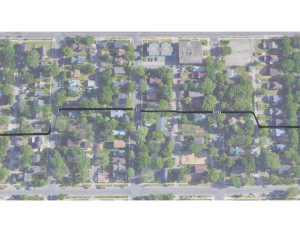‘Phillips Imaginary’ Archives
Phillips Imaginary: No. 1

Diagonal Pedestrian Paths with Mary Ellen Kaluza By MATTIE WONG, Radicle Land Collective An imagined rendering of a diagonal pedestrian/bike path through a city block. The pathway itself could be gravel and not add more impermeable paving to the urban environment. SOURCE: Radicle Land Collective The purpose of Phillips Imaginary is to consider alternatives in our built environment from the minds of residents, whether or not they would ever be considered in reality. You can’t build or debate what you can’t imagine, first! In this inaugural article, Radicle Land Collective talks to Mary Ellen Kaluza, a long-time Phillips resident, about diagonal cut-throughs to aid pedestrian movement in our very gridded city. The midwestern grid we are so familiar with was devised by Thomas Jefferson during the late 1700s when various purchases of land were made. The grid was seen as an efficient way to survey and parcel out the land in order to be sold off and settled to fund the [...]










